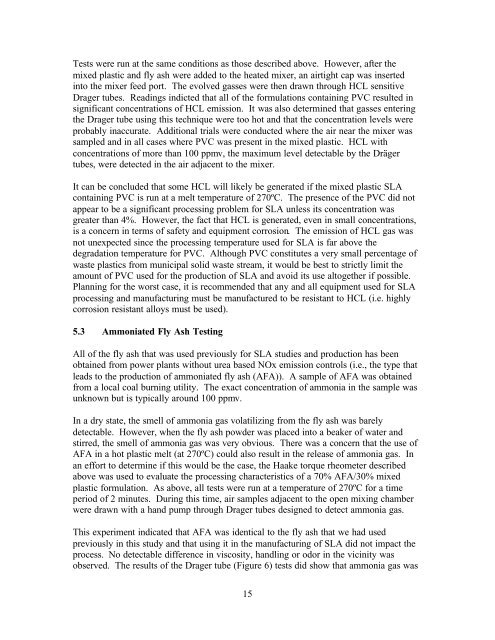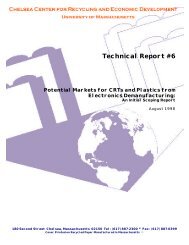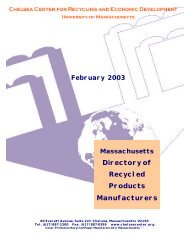fly ash/plastic synthetic aggregate for construction material
fly ash/plastic synthetic aggregate for construction material
fly ash/plastic synthetic aggregate for construction material
You also want an ePaper? Increase the reach of your titles
YUMPU automatically turns print PDFs into web optimized ePapers that Google loves.
Tests were run at the same conditions as those described above. However, after the<br />
mixed <strong>plastic</strong> and <strong>fly</strong> <strong>ash</strong> were added to the heated mixer, an airtight cap was inserted<br />
into the mixer feed port. The evolved gasses were then drawn through HCL sensitive<br />
Drager tubes. Readings indicted that all of the <strong>for</strong>mulations containing PVC resulted in<br />
significant concentrations of HCL emission. It was also determined that gasses entering<br />
the Drager tube using this technique were too hot and that the concentration levels were<br />
probably inaccurate. Additional trials were conducted where the air near the mixer was<br />
sampled and in all cases where PVC was present in the mixed <strong>plastic</strong>. HCL with<br />
concentrations of more than 100 ppmv, the maximum level detectable by the Dräger<br />
tubes, were detected in the air adjacent to the mixer.<br />
It can be concluded that some HCL will likely be generated if the mixed <strong>plastic</strong> SLA<br />
containing PVC is run at a melt temperature of 270ºC. The presence of the PVC did not<br />
appear to be a significant processing problem <strong>for</strong> SLA unless its concentration was<br />
greater than 4%. However, the fact that HCL is generated, even in small concentrations,<br />
is a concern in terms of safety and equipment corrosion. The emission of HCL gas was<br />
not unexpected since the processing temperature used <strong>for</strong> SLA is far above the<br />
degradation temperature <strong>for</strong> PVC. Although PVC constitutes a very small percentage of<br />
waste <strong>plastic</strong>s from municipal solid waste stream, it would be best to strictly limit the<br />
amount of PVC used <strong>for</strong> the production of SLA and avoid its use altogether if possible.<br />
Planning <strong>for</strong> the worst case, it is recommended that any and all equipment used <strong>for</strong> SLA<br />
processing and manufacturing must be manufactured to be resistant to HCL (i.e. highly<br />
corrosion resistant alloys must be used).<br />
5.3 Ammoniated Fly Ash Testing<br />
All of the <strong>fly</strong> <strong>ash</strong> that was used previously <strong>for</strong> SLA studies and production has been<br />
obtained from power plants without urea based NOx emission controls (i.e., the type that<br />
leads to the production of ammoniated <strong>fly</strong> <strong>ash</strong> (AFA)). A sample of AFA was obtained<br />
from a local coal burning utility. The exact concentration of ammonia in the sample was<br />
unknown but is typically around 100 ppmv.<br />
In a dry state, the smell of ammonia gas volatilizing from the <strong>fly</strong> <strong>ash</strong> was barely<br />
detectable. However, when the <strong>fly</strong> <strong>ash</strong> powder was placed into a beaker of water and<br />
stirred, the smell of ammonia gas was very obvious. There was a concern that the use of<br />
AFA in a hot <strong>plastic</strong> melt (at 270ºC) could also result in the release of ammonia gas. In<br />
an ef<strong>for</strong>t to determine if this would be the case, the Haake torque rheometer described<br />
above was used to evaluate the processing characteristics of a 70% AFA/30% mixed<br />
<strong>plastic</strong> <strong>for</strong>mulation. As above, all tests were run at a temperature of 270ºC <strong>for</strong> a time<br />
period of 2 minutes. During this time, air samples adjacent to the open mixing chamber<br />
were drawn with a hand pump through Drager tubes designed to detect ammonia gas.<br />
This experiment indicated that AFA was identical to the <strong>fly</strong> <strong>ash</strong> that we had used<br />
previously in this study and that using it in the manufacturing of SLA did not impact the<br />
process. No detectable difference in viscosity, handling or odor in the vicinity was<br />
observed. The results of the Drager tube (Figure 6) tests did show that ammonia gas was<br />
15




